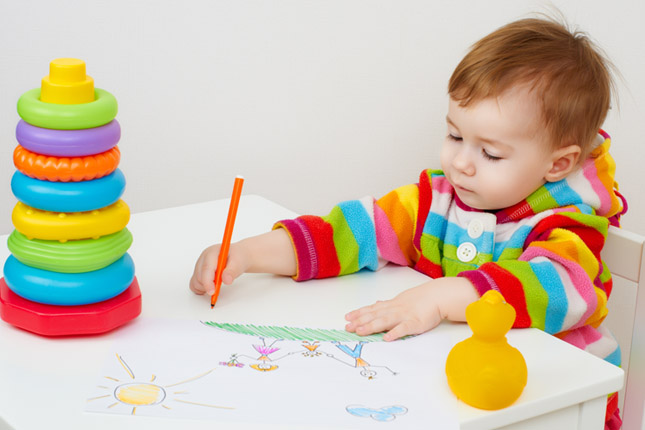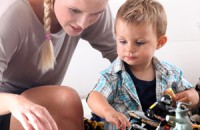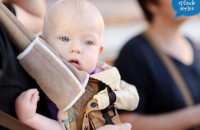Parent Savers
Montessori Learning Environment for Baby
Jeanne-Marie Paynel: You’ve probably heard about Montessori schools. However, the Montessori approach goes far beyond the schooling of children. It is a set of tools for understanding children’s developmental needs in order to provide them with the right opportunities that will help them maximize the potential they were born with. How can you bring these concepts into your home, where your baby spends most of its time? I’m Jeanne-Marie Paynel and today we’re talking about setting up a Montessori-inspired home. This is Parent Savers episode 62.
[Theme Music/Intro]
Johner Riehl: Welcome, everybody, to this week’s episode of Parent Savers, broadcasting from the Birth Education Center of San Diego. Parent Savers is your weekly online on-the-go support group for parents of newborns, infants and toddlers. I’m your host, Johner Riehl. Thanks again to all of our loyal listeners who joined the Parent Savers Club. Our members get all of our archived episodes, bonus content after each new show, plus special giveaways and discounts. Subscribe to our monthly Parent Savers newsletter for a chance to win a membership to our club each month.
Another way for you to stay connected is by downloading our free Parent Savers App. You can get that on the iTunes App Store or on Google Play. Please download that so you know when our latest podcast is released. At Parent Savers, we gather a group of parents to talk with experts about topics and today we are joined in the studio by three panelists in addition to our expert, and all of these panelists are some of our super-parents. They’re folks that you may recognize from being on the show before. I’ve got Laurie, Ursula and Scott here. So just a reminder for everyone, let’s go around the room and talk about how many kids we have and what we do.
Laurie Babb: My name is Laurie Babb and I have two boys. One, Lorenzo, is five, and Marcello is two and a half. I own a local small business and I’m also an educator.
Ursula McDonald: Hi. I am Ursula. I have two boys – Desmond and Callan. Desmond is four and Callan is two.
Scott Kilian: I’m Scott Killian. I am 36. I am a certified financial planner. I have one son, Alex, and he is three.
Johner Riehl: And I’m your host, Johner Riehl, and I have three boys. Quinner is six, Whitaker is four, and Zyler is two. And our expert Jeanne-Marie is here as well. Jeanne-Marie, do you have kids?
Jeanne-Marie Paynel: I do. I have two: a daughter who is sixteen – Eliza – and Adrian, a boy, who is twelve.
Johner Riehl: Nice.
[Theme Music]
[Featured Segment: Questions about Kids with Special Needs]
Johner Riehl: Now we have a question from Ruby. Ruby wrote us and said, “My daughter was playing on the playground today and she met a little girl with Down syndrome. She could tell something was different about this little girl and later she asked me about it. My daughter is almost three years old. What is the best way to talk to her about this?
Amy Goyal: Hi, Ruby. It’s Amy Goyal, special needs expert from Tadpoles Therapy, here to help you and answer your question. First of all when you talk to your daughter keep your answers simple and age-appropriate. Kids don’t need to know all the complexities of a medical condition. It’s too much for them. Especially if this is the first time being exposed to the subject. There are tons and tons of topics and concept that would be awesome to teach your daughter. To start with, I’d pick the one that seems to take up most of her attention and begin there. For example: your daughter noticed a girl at park that seemed different. You can begin to talk to her with the idea in mind that you want her to learn that everyone she meets, everyone that she comes across in her lifetime is different, whether they have a disability or not. Your explanation might start with something like this: “That little girl’s body works and looks differently than yours. But we’re all different and that’s ok. That’s the way we were born.” You can elaborate and give her examples about what you’re talking about, saying something like “We know people with blue eyes, we know people with brown eyes; some people are tall, some people are short. Your daughter might not have freckles, but the neighbor’s kids do.” Another example would be: “Some kids were born with eyes that don’t work as well as yours and they need glasses to help them see better.” The point is that different is acceptable and different is normal. Teaching your daughter that we’re all made differently is one way to avoid sending the message that a child with special needs is damaged. Different does not mean damaged. Different is almost that term of normal. We’re not all made the same. As you begin to talk to your daughter you might find that you’re searching for the right words to say or the right examples to give. If you find this happening to you go to the library or go to the bookstore and search for children’s books related to Down syndrome. There are several out there, they are written at the preschool level and have characters with Down syndrome. You just might be able to find one out there that talks about the topics that you want to share with your daughter. And it takes the pressure off with you. You are an amazing mom for wanting to introduce your daughter to kids with special needs. Best of luck to you and thank you for your question.
[Theme Music]
Johner Riehl: Today’s topic is all about the Montessori learning environment and bringing it into your home. Today we’re talking with Jeanne-Marie Paynel from Viola Montessori. Thank you for joining us.
Jeanne-Marie Paynel: Thank you. It’s actually Voilá Montessori. (Laughs)
Johner Riehl: Oh, (laughing) that makes a lot more sense. Let’s start by talking about the Montessori Method. I know many of us have heard of it, but usually when I have conversations with friends about it there are maybe some misconceptions… Let’s, from a broad view, talk about the Montessori Method is.
Jeanne-Marie Paynel: Basically Montessori was developed more than a hundred years ago by Dr. Maria Montessori. She basically taught us to observe children and really taught us about the universal needs of children all over the world.
The actual educational method, when you are in a school setting – some of the principles are that there’s a prepared environment, that we actually create an environment for children. Her first school was named Casa dei Bambini, which means children’s house, and we have kept that name for children’s schools. There are limits and order; order is very important in the environment. There is a mixed age group that there are windows of developmental needs, so children usually stay together about three years with the same guide. It’s all reality-based; we give real information about the world, no fantasy and ferries and so on and so forth. There is a real freedom of movement; we do not constrain children to sitting at a desk and in a certain place. They move about. A lot of the lessons actually involve movement a lot.
One of the very important concepts to me is the uninterrupted work cycle. In traditional schools we tend to constantly interrupt our children every twenty minutes; they need to change, to go to math, to music, to do different things. And here we’re letting them really get involved in their work and concentrate. And so for the three to six-year-old, for example, the ideal is a three hour interrupted work cycle. And the children will waver in and out of their work that they have chosen on their own.
Johner Riehl: When you say a lot of those principles that it’s based on, a lot of the confusion I hear about with Montessori has to do, I think, with processing this concept of freedom and three hour chunks with structure and order.
Jeanne-Marie Paynel: Right. That is one of the misconceptions that it’s a school where children do whatever. But it’s freedom within limits. There are definite limits. Children, we know, thrive on limits. And, for example, one of the examples of the limit, when I was working in a classroom, is that children are shown how to use certain material; they’re given a lesson, they’re all individual lessons. And so the children choose only work that they have been shown. So that is one of the limits. Because a two-and-a-half-year-old is not going to be able to do the work of a five-and-a-half-year-old. So they know that if they go on the shelf and take that work off, somebody is going to tell them – it’s usually an older child who’s going to tell them – “Have you had a lesson?” And that’s a limit. So they put it back and they know that they can only choose the material that they have been shown, so that is a limit. And it just brings on self-discipline and self-directed work.
Johner Riehl: That’s interesting. Our oldest is in kindergarten and the teacher mentioned to us that she can tell which kids have been to Montessori, which kids have been to a specific daycare in town, which kids. And she really appreciates the Montessori kids.
Jeanne-Marie Paynel: Yes. Because it’s all based on the idea that we’re all born with the drive to learn and to adapt to the culture, the time and place that we’re born into. And so we just create an environment so that the children can thrive and adapt to their time and place.
Johner Riehl: So a lot of it, then, we associate Montessori with schools. But you actually talk about bringing it to the home.
Jeanne-Marie Paynel: Exactly.
Johner Riehl: Why is it so important to bring it there too?
Jeanne-Marie Paynel: Well, for, one, it all started from the fact that parents were bewildered by how different their children were in the classroom setting than they were at home. And Montessori is very much based on the environment that we create for our children. So I thought, “well, then we need to look at the home environment and see what we can do to alternate so that the children are peaceful, self-driven, self-disciplined and independent at home. And it’s really very simple changes and adaptations that are made in the home for children to feel welcome and be able to be independent.
Johner Riehl: It’s a really interesting point, because I think a lot of us have experiences with, and we’ve talked about it on some previous episodes, that our kids will act one way with other people and then we get the bad parts of them, sometimes it feels like they’re not as structured.
Scott Kilian: Be authentic.
Johner Riehl: That’s right. Have you guys… Ursula did you say you went to Montessori school?
Ursula McDonald: I did. I had a wonderful, wonderful experience at my Montessori school. I was born in ‘77, so this was the late 70s or late 80s when I attended. And from what I remember, I remember a lot of activities being things like learning how to tie shoelaces, or learning how to tell time, things like that. I remember a lot of freedom. We had a garden, we were doing a lot of painting and stuff. That’s as much as I can specifically remember, but I do remember how important I felt growing up of having that experience. I don’t know how many adults look back on their time and preschool and really cherish it, but I do. My son does not go to a Montessori preschool, but he goes to a preschool which has studied all these different disciplines and has incorporated a lot of the Montessori methods within the classroom environment, but it’s not specifically a Montessori school.
Jeanne-Marie Paynel: Just a little parenthesis about the preschool experience. I was listening to an interview of the founders of Google, who actually say that the fact that they think outside of the box and they were able to create what they created with Google was from their Montessori preschool experience. That let them kind of really choose what they were interested in. And the concept is really about following the child. Every child is different. We all have different interests. And we all want to learn; and believing that children know what they need to learn I think is really important and just giving them that freedom.
Johner Riehl: That’s really interesting. So let me talk a little bit about your journey with Montessori. And I noticed, as you talk about it, you’re saying “we, we”. Is it kind of like a family once you’re in it?
Jeanne-Marie Paynel: I think it is. It’s a very strong community definitely.
Johner Riehl: Did you go to Montessori preschool?
Jeanne-Marie Paynel: I did not go to Montessori preschool. I actually discovered Montessori… I have a brother who is twelve years younger and he went to Montessori, so I was kind of into that. We used to go to school and help out a lot and so on. And when I really read about Montessori I was pregnant with my first child, so it was 16 years ago. And it just really opened up my eyes about… you needed to be intuitive and really let the child show us what they’re capable of and I’ve always believed that children are way, way, way more intelligent than we give them credit for. So I read this book in French that was called “L’enfant” and it’s translated into “The Secret of Childhood”, by Dr. Maria Montessori. And then that was that. I just went on with my parenting. I was a graphic designer, and… midlife crisis… kind of like “Ok. I’ve always wanted to work with children. What could I really do?” And I looked into the Montessori training - and there’s actually a Montessori training center here in San Diego – and went back to school. And I got my Master’s in Montessori education. So I first trained for three to six-year-olds – because, again, it’s by developmental windows – and then went back and did my birth to three. So I am now trained from birth through six.
Johner Riehl: And this idea, bringing these methods to the home, is that kind of a new thing?
Jeanne-Marie Paynel: Well, you know, a lot of Montessori schools offer that to their parents, where they do home visits, especially for the schools that have younger children – because one misconception is that Montessori is only for preschoolers. But Montessori education really starts at conception, really the whole birth, and it goes through adolescence. Maria Montessori developed different environments all through adolescence.
So the birth to three really opened up my eyes about how much we could be doing to help parents understand their role and how they could prepare the home. So to me that’s really important and I think it needs to be broader and brought to the general public and not only to those who go to Montessori schools.
Johner Riehl: Alright, so when we come back after the break let’s dive into some specifics about bringing it into your home with Jeanne-Marie Paynel from Voila Montessori (and I nailed it this time). We’ll be right back.
[Theme Music]
Johner Riehl: Welcome back, everybody, to Parent Savers. Today we’re talking about creating a Montessori environment for your kids in your home with Jeanne-Marie Peynel from Voila Montessori. So let’s talk about the different stages of development. You talked about your training right before the break. Let’s talk about that birth to three years and what we need to do for kids and how we can bring that to the home.
Jeanne-Marie Paynel: For one, the understanding the stages of development – I think it’s really important for parents to read up a little bit – not too much, I think parents can get involved in too many facts – and just know that children are born with a hundred billion neurons just waiting for connections to be made. And that there is this immense potential in them and that they will only develop all these skills if they’re given proper language, if humanity is modeled properly to them. So one of the very first stages is that whole bonding stage. That whole first two months is really important. And it’s giving the child trust in the world and it’s really one of the first psychological legs to personality development. So just understanding your important role of being with the child, with looking in their eyes, with talking to them, with holding them, with just respecting them from the very beginning.
Johner Riehl: Yeah there’s a kind of a school of thought that I’ve heard about the fourth trimester, right?
Jeanne-Marie Paynel: Definitely.
Johner Riehl: The first three months… that you maybe treat them differently in that first three months than you do… you still treat them as a baby or as a fetus almost until they’re starting to come out to their own. And you’re saying engage with them even more.
Jeanne-Marie Paynel: Engage with them and just be very respectful. I mean… Montessori talks about it as the psychic embryo, which I think is pretty powerful, because it is… just that adult in the making and we need to really respect it and hold it in reference of the potential that they have.
Ursula McDonald: That’s so important. I really vibe with that. This theory that… we’re the parents and they’re these little people, but there are full grown spirits inside them and we just need to be their guides rather than their authority figures.
Jeanne-Marie Paynel: Authority and wanting to control everything. It’s really about following their rhythm and parents who are expecting are already feeling a rhythm within them. So when they’re born they have their own rhythm and it’s just being in tune with it and just going with the flow and not trying to control everything all the time.
Scott Kilian: So it’s kind of like, let’s say, instead of a chart on the wall saying “by this age, by this age, by this age, by this age” – instead of doing that it’s more like let’s look at the child and let’s see what’s happening and go with the flow.
Jeanne-Marie Paynel: Let’s look at the child, but it’s interesting that you bring up the chart, because there is a universal chart. Every child on this planet has the same milestones. And they come about them maybe a few weeks, months of differences, but they will all evolve in the same way and in the same sequence. So it’s just respecting the flow of life and even… I see with my two children how different they were, they just came about differently, so it’s really respecting their individual personality.
Scott Kilian: So in that sense does the chart even matter?
Jeanne-Marie Paynel: I don’t think it does. I mean I know that I have had to tell parents to stop reading, stop comparing, because… I had this one mom – every day she was looking on the internet, “y son should be doing this, my son should be doing that” and I said, “You know what? Get down on the floor and enjoy being a parent. Just be there with them, communicate, be there, enjoy it.”
Johner Riehl: Yeah, there’s the benefit to getting those emails and seeing where they are, but that’s also the downside.
Jeanne-Marie Paynel: You can get kind of wrapped up.
Ursula McDonald: You have to read the disclaimer at the end. It always says “each child is an individual and this is just a guide”.
Jeanne-Marie Paynel: Each child is an individual and each parent is an individual, too. You know, we react differently and we just need to get back to our intuitive… We were children once. We just need to get back there.
Johner Riehl: We should put that disclaimer on this show.
Ursula McDonald: I’m curious, what are the things that parents can do in the home to bring these… is it setting up stations, is it setting up specific time for certain activities? How do you do it?
Jeanne-Marie Paynel: From the beginning it’s understanding that children are very sensitive to order and routines. So what I really recommend is that parents, as they’re waiting for the child to arrive or even if the child has arrived, is to know about the four basic areas in the home. And that’s the sleeping area, the feeding area, the physical care area and the movement area. And just to know that your home is going to change a little bit and that you just need to have those areas ready for the child and that ideally they’re always the same, because again it’s about having a routine, about giving security to the child that they know what’s expected of them when they go to that certain area. It’s really a very simple setup. I don’t really believe in the big production of nurseries and fluffy and all this. It’s really very simple. Low to the ground, children are small. So let’s keep it small and have things for them low. So it’s really a very simple setup where there are minimal toys that are organized in baskets. On a low shelf the children see them right away, they will know to be able to go get them and also to put them back, which is very important.
Ursula McDonald: I have a question about what you just said about the four environments – so the sleeping… I’m hearing a contrast between the sleeping and the movement environment.
Jeanne-Marie Paynel: Yes.
Ursula McDonald: And does that mean… I know my kids like to play in their bedroom a lot. Does that mean that the Montessori way would say maybe better not to do that in the bedroom?
Jeanne-Marie Paynel: No, not at all. It’s just that the sleeping area should be a… what I really recommend is a small, good quality, organic mattress low to the floor; a floor bed really. So that’s all there is there. There are no distractions. The movement area for a child who is not yet quite mobile, who isn’t crawling yet, is a very nice little movement mat somewhere else in the room, and it can be in their bedroom definitely, preferably up against a wall with a low mirror along that movement mat – children love to see themselves, it encourages them to move, to go towards it. It gives them feedback about their body, about their body scheme. And later on you can put a ballet bar against that mirror, where they’re going to start trying to get up on their two legs, because that’s all they want to do. They see us walking, that’s their goal, that first year, to start walking. So it’s really just a separate area, so that when a child is put down on that sleeping area, they know what’s expected of them, that this is where I relax, this is where I go to sleep.
Ursula McDonald: So it sounds like this is more for the very early ages.
Jeanne-Marie Paynel: It’s for the very early ages, because once a child does start crawling the entire home becomes the movement area; definitely the entire home. And I really emphasize that the entire home is and that there are certain little adaptations that you need to make; and they are temporary, because children do grow up and those beautiful objects that you had on the coffee table will be able to come back down one day. But for now just put them up and just let them explore. Movement is very important for brain development, for personality development, for self-esteem, for everything. Movement is life.
Ursula McDonald: I know one of the challenges I have – because my son went to a Montessori preschool and he still is there – was trying to incorporate more of those principles and just clutter all the stuff that you accumulate, all the toys, all the books. And just trying to keep it more simplified has been a huge challenge for me, so that they are not overwhelmed with these toys overflowing out of the buckets.
Jeanne-Marie Paynel: I really help parents de-clutter and get rid of a lot of things.
Ursula McDonald: Right.
Jeanne-Marie Paynel: There are so many things that we have in the home that are so much more beneficial to our children than all the toys that people want to give us and we buy that have lights and buzzers and plastic and all this. I really believe that one of the things for the younger children is a discovery basket. And in that basket are really wooden spoons and safe kitchen utensils or other things that they can explore, that are made of natural material, that we can give them proper language for. And that’s it, all they really need. They really need to be outside and playing in the dirt, not all that stuff. So I would just ask that maybe you look through it and see what is the purpose of those toys, what is the intelligent purpose of them and those that you say there’s nothing – put them away. Donate.
Ursula McDonald: Oh, yeah. Probably all parents can relate to the complexity of that. Because then it expands into the relationships that are tied in those, like “Grandma, I gave that to you!” And you’re trying to figure out a way to negotiate those while not sounding like the tyrant of “this is the way the environment is supposed to be”, that kind of thing.
Ursula McDonald: You’re right. But I think it’s our role to also educate our friends and family as to what it is our goal is with our children; that you would much rather, instead of spending money on all these toys, museum membership or taking them on a trip or on a hike, or different things would be much better than these toys that honestly… We often say that the children play with the cardboard box that the toys came in. And they really do. That is not a lie, they really do. So: simplify it.
Ursula McDonald: What about rotating things? Because I’ll put their toys up on a shelf or in the closet away, so what they have down and available is kind of organized as far as a box of blocks or a box of this, or whatever. And then every couple months I’ll rotate it out and switch it out.
Jeanne-Marie Paynel: That is perfect, because if we observe our children we will see what they’re interested in and what they’re playing with. Once they’ve stopped playing with. Also a good sign is when they start misusing something – that means that they’re bored with it or done. So take that away and trade it in for something else. Something that they played with three weeks ago will suddenly be this whole new toy and this whole new way of playing with it. But really keeping only four or five things out is really ideal. All the rest can really be put away. Activities for older children are to try and keep everything self-contained, so that there isn’t that dependence on you. For example, if it’s a pasting: make sure that on that trey there is the paper and there is scissors and the glue and the brush; that they have everything so that they can independently go and get it; go to their table, do their work, put it back. That they don’t need to say “Hey, mom, hey, dad, where’s the paper, where’s the glue, where’s the scissors?” So that they can initiate the activity and do it on their own.
Johner Riehl: Yeah. And that independence feels so good.
Jeanne-Marie Paynel: Exactly.
Johner Riehl: Really quick, what do you mean by physical care area?
Jeanne-Marie Paynel: Physical care area is when they are newborn and until they are toilet independent. It’s really where you care for them. So it’s where you’re going to change them, where you’re going to dress them, where you’re hopefully going to give them massages. It can be in parallel with the bathing area as well.
Johner Riehl: So have an area designated? Because by the time our third kid was around we just changed the diaper wherever.
(Laughs)
Jeanne-Marie Paynel: You know, it’s funny, I hear that a lot. But I think that it’s kind of important at the beginning to just have a place that is comfortable for the caregiver. So it can be on the floor, on the bed or wherever. It needs to be comfortable because it’s intimate time that you spend with that child, where you’re giving them information about their body scheme, their body image, you’re giving them a lot of language, you’re letting them know what you’re doing. And so it needs to be a nice place for you, so that you have everything you need. People who do use changing tables – what I want them to keep in mind is that they have it facing the child. Often times are changing tables nowadays sideways; so we’re tending to our child only on one side.
Johner Riehl: Mmm that’s right.
Jeanne-Marie Paynel: And so again you’re giving them information about their body scheme. So just turn it around or be at one end so you’re facing them and you’re caring for their entire body in equal proportions.
Johner Riehl: So much seems to come down to this conflict between convenience for parents and what’s best for the kid; they don’t always match up. And so it seems like a lot of what you’re doing is putting the focus back on the needs of the child.
Jeanne-Marie Paynel: It’s the need of the child, but it’s the need of the family. Just like for me the feeding and the physical care area are really areas where the caregiver needs to be comfortable, have everything right there at hand. The feeding area for me has to be a very comfy, relaxing chair where whether you’re breastfeeding or bottle feeding, you can enjoy that moment. It should be distraction free – get rid of those phones and those TVs and be there with your child. It’s a lot about self-esteem, that whole feeding time. So to me it complements the family.
Johner Riehl: So, as we wrap this up: you don’t show up at somebody’s house with a briefcase full of Montessori stuff, instead you are giving advice and guidance. What would your top advice and guidance be for parents interested in that?
Jeanne-Marie Paynel: Well for one I do go to people’s homes. But what I say is that I am looking at the environment from the child’s perspective. So really from the child’s point of view. So depending on the age of the child – and this is from birth through six – I will look around and see. I usually sit and observe for a little bit, see what the dynamics are. If this three-year-old keeps on asking for water and there’s no place for him to get water on his own – well that’s going to be a suggestion, of putting a little picture if water with a cup that’s down at his level, so that when he is thirsty he can go get water. There’s no reason why he needs to wait for somebody to be available to give them water and that the parent is “Oh, are you thirsty?” I like to think of it as a special guest coming to stay with us for a while. I mean for a long time, but… just like when you have a special guest from out of town, you do some little modifications in your home so that they are going to be comfortable. So it’s the same thing. It’s the same thing for the child.
Johner Riehl: Instead we try to control our kids.
Jeanne-Marie Paynel: Exactly. So a lot of the modifications actually end up being in the kitchen. Children love being in the kitchen. They love participating in the kitchen. So finding child-size tools, just letting parents know how to give the simple task of a recipe to the child, letting them participating with just giving them a potato and a brush is such an empowerment for them. They feel that… “the whole mashed potatoes?” No, they only scrub one potato; you probably will never see that potato again, but that’s ok. They participated in it and that’s really important. So it’s really the kitchen, the bathroom a lot. Simplifying the toys is a big one. A lot of times I have parents that go, “Oh my god!” The other day I walked into this three-year-old’s bedroom and I was overwhelmed. So I can imagine how this young child feels. And it was beautiful because I went back a week later and mom had gone through everything and had really gotten rid of a lot. Because it’s true, they accumulate. Grandma and aunt and all this gave us these things, we don’t dare put them away, but I think we can.
Johner Riehl: Fascinating topic. Unfortunately we’re running out of time. But thank you so much, Jeanne-Marie, for joining us from Voila Montessori. Thanks also to Ursula, Scott and Laurie, our super parents, for contributing as well. For more information about today’s topic or for more information about any of our super parent panelists visit the episode page on our website.
The conversation continues for members of our Parent Savers Club after the show. Jeanne-Marie will tell us a little more about the positive discipline method, which could probably be its own show in and on itself.
Jeanne-Marie Paynel: It should be, yes.
Johner Riehl: But I just want to go over that a little bit, because it does kind of tie into what you do. But yes, we may need to revisit that topic in the future in more depth. For more information about the Parent Savers Club visit our website, ParentSavers.com.
[Theme Music]
[00:25:55]
[Featured Segments: A Parent’s Babysitting Guide. What Qualifications Are Needed? ]
Jodi Sornborger: Hi, Parent Savers! This is Jodi with UrbanSitter, a website that connects you to friend-tested sitters. I’m here to help you figure out the right type of questions to ask when searching for a babysitter. Such as: what qualifications should my sitter have? So you found a sitter that has experience. But what other qualifications do they have? The primary qualification to look for in a sitter is CPR certification and first aid training. If you find a great sitter who isn’t CPR-certified you can always offer to pay for a class or, better yet, take one with her. It’s a great excuse for you to brush up on your CPR, too. Ask your sitters to dig deeper into their qualifications. Questions you might not think to ask, like “do you speak another language”, “do you know how to cook”, “are you willing to help with errands and household chores”. These additional skills may just be the icing on the cake. It is possible to find a sitter that can communicate to your infant’s sign language or help with the math homework. Or better yet, when you go on vacation maybe you can take that sitter along with you. Ok, Parent Savers, it’s time to say hello to your old friend spontaneity. Visit Urbansitter.com to find the babysitters your friends know and love.
[Theme Music]
Johner Riehl: That wraps up everything for today on Parent Savers. Thanks again to Jeanne-Marie Paynel from Voila Montessori. I appreciate you all listening to Parent Savers. Don’t forget to check out our sister show Preggie Pals for expecting parents, and our show The Boob Group for moms who breastfeed their babies. Next week we are going to be talking about potty training during sleep time, kind of the final frontier of… accidents. This is Parent Savers empowering new parents.
[Disclaimer]
This has been a New Mommy Media production. Information and material contained in this episode are presented for educational purposes only. Statements and opinions expressed in this episode are not necessarily those of New Mommy Media and should not be considered facts. Though information in which areas are related to be accurate, it is not intended to replace or substitute for professional, Medical or advisor care and should not be used for diagnosing or treating health care problem or disease or prescribing any medications. If you have questions or concerns regarding your physical or mental health or the health of your baby, please seek assistance from a qualified health care provider.
[00:36:21]
[End Of Audio]











